Attractions Nearby Udaipur, Day Trips and Excursions
(Udaipur, Rajasthan, India)
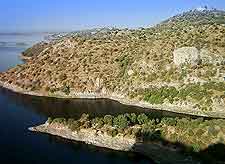
There is plenty to see and do within Udaipur, although many tourists do like to venture outside of this city and head to one or two of the neighbouring attractions around Rajasthan, best reached by bus or train. Standing a mere 21 km / 13 miles to the north of Udaipur, Eklingji is home to a magnificent and very old Hindi temple complex, with attractions originating from the end of the 10th century.
Jaisamand Lake is just under 50 km / 31 miles to the south-east of Udaipur and is one attraction not to miss. Also going by the name of Dhebar Lake, visitors can expect to find a simply vast man-made lake, which covers an area of almost 90 square kilometres / 35 square miles, making it amongst the biggest lakes in the whole of Asia. Further afield, long-distance trains connect Udaipur with a number of major Indian cities and towns, such as Chittorgarh,
Jaipur,
Jaisalmer and even
New Delhi.
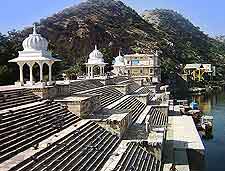
Jaisamand Lake (Dhebar Lake)
The Jaisamand Lake actually came into being by damming the Gomti River during the 17th century and various beautiful 'chhatris' (Indian pavilions) and summer palaces of the maharajas surround the lakeside embankment area. Udaipur tourists may also be interested in visiting the attractions at the Jaisamand Wildlife Sanctuary, where panthers, leopards, deer, antelope, wild boar and exotic birds all await. Alternatively, check out the luxurious Jaisamand Island Resort, which is just a 20-minute boat ride away.
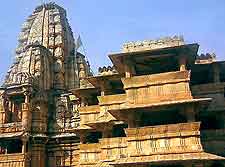
Dungarpur
Dungarpur lies around 110 km / 68 miles to the south of Udaipur and when first settled in the 13th century. Also known as the 'City of the Hills', Dungarpur contains a number of worthy attractions, including the deserted palace of Juna Mahal, where some elaborate murals are to be found covering the walls, including one very discreet mural of the karmasutra, which is tucked away within a cupboard. While you are visiting Dungarpur, do also check out the awesome views from the former royal hunting lodge, and if you have time, head out of town and visit the nearby Deo Somnath Temple, which dates as far back as the 12th century.
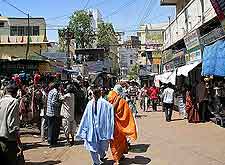
Eklingji
In total, Eklingji comprises in excess of 100 temples, created out of granite, marble and sandstone, and honouring the Mewar monarchy. The Shiva Temple in particular stands out and was completed at the beginning of the 16th century, being acclaimed for its stylish pyramid-shaped roof and huge pillared hall, and regularly visited by pilgrims from all over India.
Open hours: daily - 06:00 to 10:00 and 17:00 to 19:30
Admission: free, no leather good allowed, socks and shoes must be removed
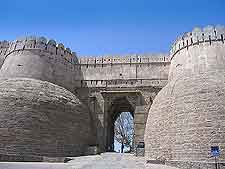
Kumbhalgarh (Kumbhalmer)
Located within the Rajsamand area of Rajasthan, Kumbhalgarh is home to a spectacular, remote fortress of grand proportions, with perimeter walls stretching for over 30 km / 19 miles, which are reputed to be the longest in existence, after only the
Great Wall of China. The Kumbhalgarh Fort is to be found around 80 km / 50 miles to the north of Udaipur and this impressive Mewar fortress is well worth experiencing in the flesh, being where many Indian rulers came in times of danger. Attractions within the fort walls are access through the gigantic Ram Gate (Ram Pol) and include some 360 different temples, numerous palaces and formal gardens, and a total of 700 cannon bunkers. Close by, the rugged and spreading Kumbhalgarh Wildlife Sanctuary contains a wealth of native wildlife, including a large pack of wolves, hyenas, leopards and jungle cats, amongst other interesting creatures.
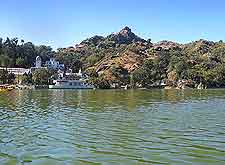
Mount Abu
Mount Abu really is a very unique spot in Rajasthan and provides something quite different to visit. This prominent hill town can be reached by travelling along a rather scenic and winding road, which passes everything from Alpine sloper to sandy desert plains. Around Mount Abu, a number of recreational attractions and activities present themselves, with the hiking trails being especially popular and affording some awesome mountain views. If you fancy it, there is a large lake with pedalo boats shaped as swans, or alternative, you can take a stroll and visit the nearby Jain Dilwara temples, although bear in mind that the during the weeks of the Diwali festival, these temples become extremely crowded. Buses regularly travel between Udaipur and Mount Abu, with this journey lasting around six hours.
Nathdwara
Around 45 km / 28 miles from Udaipur in Nathdwara, an extremely popular day trip for holidaying tourists. The Nathdwara temple (Vaishnav Shrine) is believed to be nothing short of an actual pathway to the Lord Shri Krishna ('Gateway to the Lord'), and therefore understandably attracts large numbers of pilgrims each year, who flock here during festivals, such as Holi and Janamashtmi. Next to the temple itself, the town of Nathdwara may also be of interest and contains many small shops selling all kinds of gifts, including 'pichwai' paintings (traditional fabric paintings).
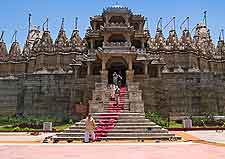
Ranakpur
Those heading for Ranakpur are in for a real treat, and quite a surprise. Ranakpur is located around 90 km / 56 miles to the north of Udaipur and lies within a deep, heavily wooded valley. Here you will discover a huge temple complex constructed in bright white marble and boasting over 1,400 supporting pillars, each of which is quite unique, with individual carvings. It is quite clear to see the craftsmanship and pride involved in creating these mammoth structures, which are believed to have been completed during the early part of the 15th century. The main attractions within Ranakpur' complex include the Four-Faced Temple (Chaumukha Mandir), the Jain Temples to both Parasnath and Neminath, a grand Sun Temple, and close by, the Amba Mata Temple.
 There is plenty to see and do within Udaipur, although many tourists do like to venture outside of this city and head to one or two of the neighbouring attractions around Rajasthan, best reached by bus or train. Standing a mere 21 km / 13 miles to the north of Udaipur, Eklingji is home to a magnificent and very old Hindi temple complex, with attractions originating from the end of the 10th century.
There is plenty to see and do within Udaipur, although many tourists do like to venture outside of this city and head to one or two of the neighbouring attractions around Rajasthan, best reached by bus or train. Standing a mere 21 km / 13 miles to the north of Udaipur, Eklingji is home to a magnificent and very old Hindi temple complex, with attractions originating from the end of the 10th century.




